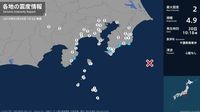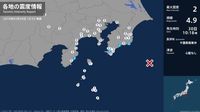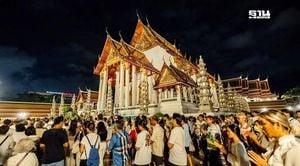An earthquake struck the southeastern coast of Chiba Prefecture and parts of Shizuoka Prefecture on March 30, 2025, at precisely 10:18 AM, registering a maximum seismic intensity of 2. The Japan Meteorological Agency (JMA) reported that the epicenter was located approximately 60 kilometers deep in the sea, with the earthquake measuring a magnitude of 4.9.
The tremors were felt in several cities across the two prefectures, with Katsuura City, Tateyama City, and Kamogawa City in Chiba experiencing the strongest shaking at intensity level 2. In Shizuoka Prefecture, Higashiizu Town also reported a maximum seismic intensity of 2. Meanwhile, a broader area, including parts of Tokyo and Kanagawa, experienced a lesser intensity of 1.
According to the JMA, there was no threat of a tsunami following the earthquake, which provided some reassurance to residents in the affected regions. The agency emphasized that while the earthquake was significant, the depth and location mitigated the risks typically associated with seismic activity of this nature.
Reports indicate that the earthquake was felt as far away as Tokyo, where areas like Chiyoda Ward and Suginami Ward recorded a seismic intensity of 1. Other locations in Kanagawa and Yamanashi Prefectures also experienced similar tremors, demonstrating the widespread reach of the earthquake.
In Chiba Prefecture, additional cities such as Kimitsu City, Minamiboso City, Isumi City, Otaki Town, Ichinomiya Town, Mutsuzawa Town, and Chiba Mihama Ward reported a seismic intensity of 1. This level of intensity suggests that while the earthquake was noticeable, it did not reach a level that typically causes significant damage.
In Kanagawa Prefecture, the earthquake was felt in multiple areas including Yokohama Kanagawa Ward, Yokohama Naka Ward, and Yokohama Hodogaya Ward. Other cities such as Kawasaki Nakahara Ward, Kawasaki Miyamae Ward, Yokosuka City, Chigasaki City, and Miura City also reported a similar intensity level.
Yamanashi Prefecture was not spared either, with Yamanakako Village and Fujikawaguchiko Town recording a seismic intensity of 1. The earthquake's impact was felt across a wide swath of the Kanto region, highlighting the interconnectedness of seismic activity in Japan.
As with many earthquakes in Japan, emergency services were put on alert following the tremors. Local authorities conducted checks on infrastructure to ensure that there were no immediate threats to public safety. Fortunately, there were no reports of injuries or significant damage, which is often a concern following seismic events.
The JMA continues to monitor the situation and has advised residents to remain vigilant, as aftershocks can occur following a significant earthquake. They have recommended that individuals in the affected areas prepare for potential aftershocks and ensure that their emergency kits are stocked and ready for use.
This earthquake serves as a reminder of Japan's ongoing struggle with seismic activity, given its location along the Pacific Ring of Fire. The country is well-prepared for such events, with stringent building codes and extensive public education on earthquake safety.
In the aftermath of the earthquake, many residents took to social media to share their experiences. Some reported feeling the ground shake for several seconds, while others expressed relief that the event did not lead to a tsunami or widespread damage.
Japan has a long history of earthquakes, with some of the most devastating events in recorded history leading to significant loss of life and property. The government has invested heavily in earthquake preparedness and response systems, which have been credited with saving lives during seismic events.
As the JMA continues to analyze the data from this earthquake, they are also working on public education campaigns to ensure that residents are prepared for future seismic activity. This includes drills, informational sessions, and updates on the latest safety measures.
Overall, the earthquake on March 30, 2025, while significant, resulted in no major incidents or injuries, showcasing Japan's resilience and preparedness in the face of natural disasters. Residents are encouraged to stay informed and prepared as they navigate the risks associated with living in a seismically active region.





